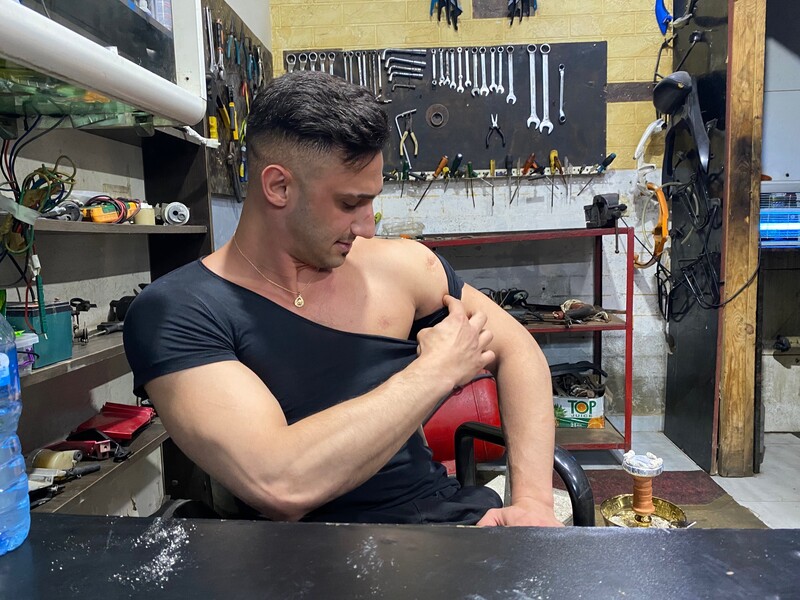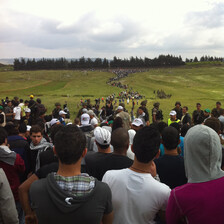The Electronic Intifada 5 July 2022

At the Shatila camp in Beirut, Nour al-Jamal points to where an Israeli sniper shot him three times during the 2011 protests in Maroun al-Ras, Lebanon. He was only 15 years old when he was shot.
In the southern Lebanese town of Maroun al-Ras, al-Quds park overlooks Palestine. From where I stood atop a hill, I could see the boundary fence and, beyond it, Israeli soldiers and their jeeps.
This was 15 May 2011, the 63rd commemoration of the Nakba, or the forcible expulsion of most Palestinians from their homeland during the establishment of the state of Israel.
An estimated crowd of 40,000 people, including Palestinian refugees and protesters from Lebanon and around the world, had gathered in Maroun al-Ras.
When a young, unarmed man hung the Palestinian flag on the boundary fence, an Israeli soldier shot and killed him.
Then, the chaos began.
With every bullet fired, more people ran toward the boundary with Palestine, seemingly fearless as Israeli soldiers fired into the crowd, killing or maiming.
Ghassan Hammad, now 31, was shot twice by an Israeli sniper, in his knee and thigh.
“Right before I was shot,” he said, “I was thinking of how close I got to Palestine. I thought to myself, no way will I go back to the camp – I have to enter Palestine or I will die trying – and, it happened, I was shot.”
He walks with a limp now as he works at his juice shop in the Burj al-Barajneh camp in southern Beirut.
His knee has been permanently damaged, with shrapnel still painfully lodged in his body.
Though he doesn’t remember much of what happened after he was shot, he does remember people shouting shahid, the Arabic word for martyr.
“Apparently they only saw the blood but could not locate the injury,” he said.
Hammad hasn’t been back to the south of Lebanon since 2011 – and he doesn’t plan to go back until he can return, for good, to his village in the Galilee, al-Kabri, northeast of Acre. Still, Hammad is proud of his wounds.
“I was targeted by the Israeli occupation soldiers while trying to return to my land,” he said. “I was not shot because I am a criminal, it is rather because I was trying to exercise my right of return.”
A dress rehearsal for Gaza
That day in 2011, Israeli soldiers killed 10 Palestinians and wounded 112 more.
Dr. Ghassan Abu Sitta, a London-based Palestinian plastic surgeon, was in Beirut in 2011 and treated some of the injuries from the protests at Maroun al-Ras.
Based on his observations of the nature of the injuries he was treating, he concluded that “the injuries were not a result of random targeting.”
Abu Sitta said that during his multiple visits to the Gaza Strip in the years following 2011, he noticed similarities between injuries sustained by Palestinians there, at the hands of the Israeli army during protests against the siege, and by the protesters in Maroun al-Ras.
“I now believe that what happened in south Lebanon in 2011 was very much a rehearsal of what later started to take place in the Gaza Strip,” he said.
“Israeli snipers were not simply shooting to stop demonstrators from approaching the fence, they were intentionally targeting to cause the greatest harm, to maim protesters.”
Indeed, over the course of nine months in Gaza, from 30 March to 31 December 2018, Israeli live ammunition during the Great Marches of Return caused 6,106 injuries, and 4,903 of those were to the lower limbs.
Israel’s “nightmare scenario”
Nour al-Jamal, 26, was shot three times at Maroun al-Ras in 2011, when he was only 15 years old.
“It was the first time I saw Palestine this close,” he said. “And all I wanted was to get as close as possible. I did not think it would cost me lengthy years of treatment.”
Al-Jamal lives in the Shatila refugee camp in Beirut, where he runs a plumbing supplies shop. Most days, he is at his shop, working.
In late May 2022, at his shop, al-Jamal pointed to the left side of his chest to show me his wound.
“I still have a bullet here. The doctor said, ‘Let’s just keep it in,’ and I have to try to live with it.”
Al-Jamal cannot raise his arm. His initial course of treatment as a teenager lasted more than two years and included five surgeries and physical therapy.
“I look back at those years and think that instead of spending my teenage years having fun and hanging out with my friends, I was just thinking about how not to lose an arm that stopped working after the bullet.”
On the day of the 2011 protests, al-Jamal remembers getting close to the separation fence.
“I was not armed, none of the people were armed,” he said.
He took a long breath.
“Apparently, us just existing in a space that is close to Palestine represents a threat to the Israeli occupation.”
Israeli governments have been vocal about the threat posed by a mass return of Palestinian refugees, with claims that such a return would threaten the very existence of Israel.
Haaretz described the 2011 Maroun al-Ras protests as “the nightmare scenario Israel has feared since its inception … that Palestinian refugees would simply start walking from their camps toward the border and would try to exercise their ‘right of return.’”
Yet al-Jamal said that even though the Israeli troops kept firing on the protesters, the protesters were not deterred: “The more people heard the gunshots, the number of people by the fence increased.”
Legitimate targets
Araby al-Andari, 41, went to Maroun al-Ras that day in solidarity with Palestinians. The Lebanese political activist, who lives in Beirut, remembered May 2011 as being a moment of awakening among Arabs, given the revolutions in the months prior in Tunisia and Egypt.
When he heard about the march in the south, he was certain he would go.
“Participating was the normal thing to do,” he said. “Palestine is our main and unifying cause.”
Once there, al-Andari noticed some younger boys near the separation fence. He went toward them to convince them to move away so they wouldn’t get shot.
“I was not trying to be a hero at all,” he said. “On the contrary.”
The boys “were holding the Palestinian flag. I snatched it from their hands. I was mad at them and I hung the flag on the fence to convince them to leave. Next thing I remember I was being held aloft on [people’s] shoulders and saw my foot almost hanging by a string of flesh. People thought I had been killed.”
Al-Andari was shocked that talking about that day had made him cry.
“I vividly remember that Hana, who is now my wife, was the first thought to occur to me when I was shot,” he said. “I just did not want to die yet.”
After a number of surgeries, al-Andari said his healing has not been easy. The scar on the back lower side of his foot looks severe, even after all these years.
“It’s not like I had a football career, but look at my foot, it looks like it exploded from within,” he said. “An Israeli sniper considered me a legitimate target.”
Yet he does not regret being in Maroun al-Ras.
“Despite everything that has happened, this injury is a badge of honor on my body, a sign that always reminds me that I am in the right on this fight.”
Amena ElAshkar is a Palestinian refugee in Lebanon, a journalist and a PhD candidate in international relations at LSE.




